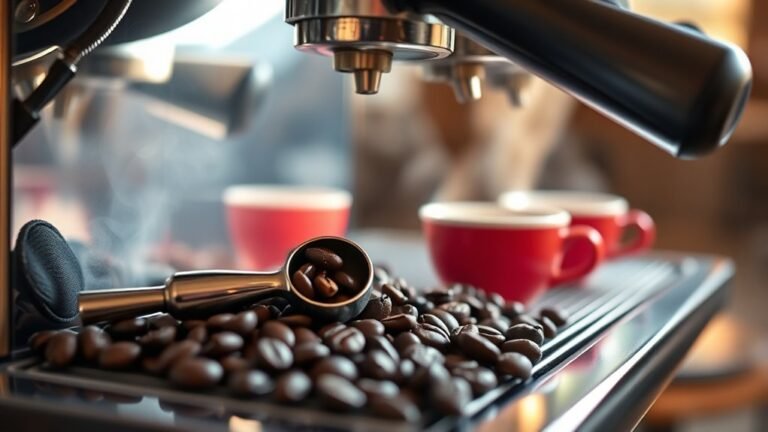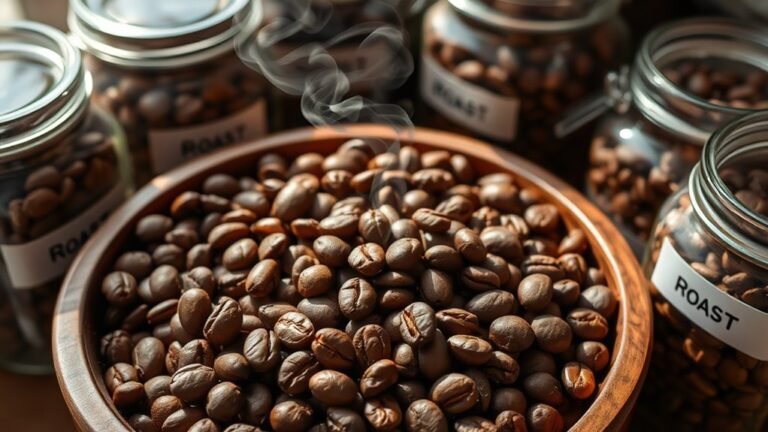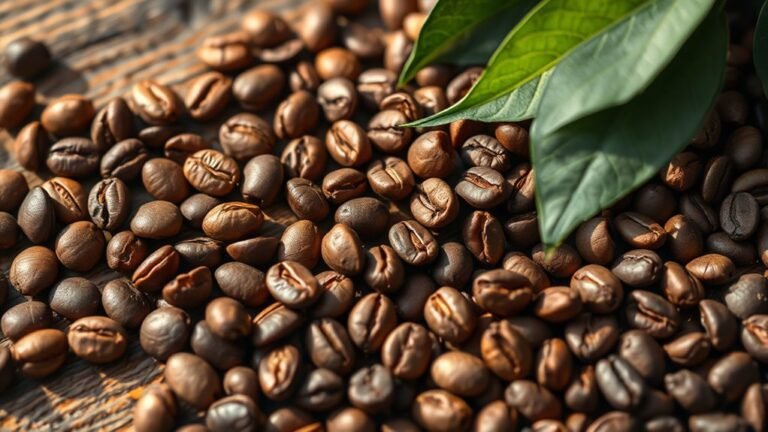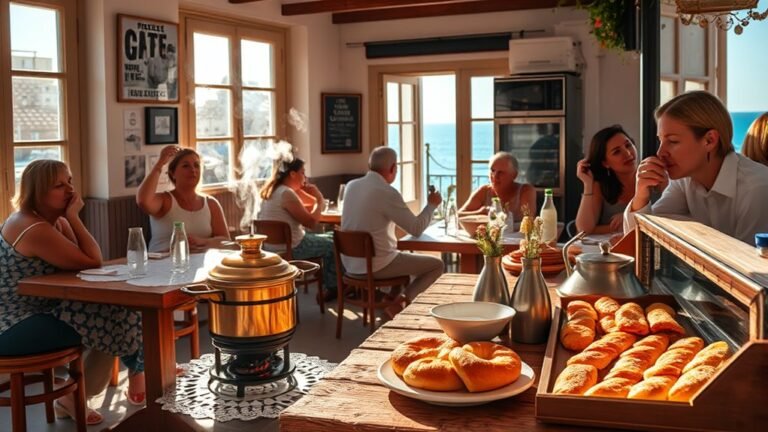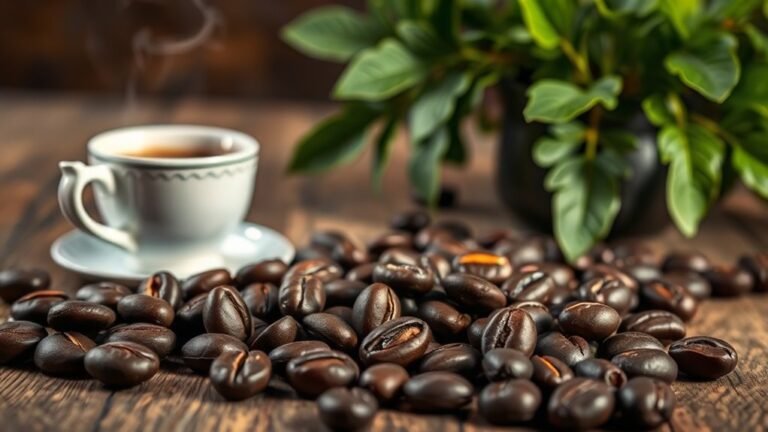The Best Decaf Coffee for Cold Brew
For the best decaf cold brew, you want Swiss Water Processed beans from single-origin Latin America or East Africa, roasted medium to dark. These maintain robust oils and complex flavors despite decaffeination, delivering smooth, earthy notes with bright acidity. Adjust your grind coarser and steep 16-24 hours below 75°F to optimize extraction and body. To reveal the full potential of decaf cold brew—from bean selection through brewing finesse—there’s much more to explore.
What to Look for in Decaf Coffee Beans for Cold Brew

When selecting decaf coffee beans for cold brew, you’ll want to prioritize beans that retain robust flavor profiles despite the decaffeination process, as cold brewing inherently mutes certain taste notes. Understanding decaf processing methods—such as Swiss Water, CO2, or chemical solvent techniques—is vital because each impacts the flavor profile differently. Swiss Water and CO2 methods preserve more of the bean’s intrinsic oils and aromatic compounds, essential for maintaining complexity in cold brew. You should also look for beans with medium to dark roasts, as they tend to offer richer, bolder notes that survive dilution and extended steeping. Ultimately, choosing decaf beans processed with methods that protect flavor integrity guarantees you’ll enjoy a cold brew that doesn’t sacrifice depth or character, granting you freedom to savor every sip.
Top Decaf Coffee Beans Recommended for Cold Brewing
Although decaf coffee often struggles to deliver the full-bodied complexity cold brew demands, certain expertly processed beans stand out for their exceptional flavor retention and balance. When selecting top decaf coffee beans recommended for cold brewing, prioritize those with refined flavor profiles—think nutty undertones, subtle cocoa hints, and bright acidity that cut through the dilution inherent in brewing methods like immersion. Swiss Water Process beans excel here, preserving origin characteristics without chemical interference. Look for medium to dark roasts that maintain structural integrity during long steeping, ensuring your cold brew isn’t flat or muddy. Brands sourcing single-origin decaf beans, especially from Latin America or East Africa, often offer superior clarity and complexity. Choosing wisely lets you break free from caffeine without sacrificing the nuanced taste cold brew aficionados crave.
How Decaf Cold Brew Differs From Regular Cold Brew
Selecting the right decaf beans sets the foundation, but understanding how decaf cold brew fundamentally differs from its caffeinated counterpart is key to mastering the craft. The decaf process—whether Swiss Water, CO2, or chemical solvent—removes caffeine while subtly altering the bean’s chemical matrix. This impacts the flavor profile, often muting acidity and reducing bitterness, which shifts the cold brew’s balance. You’ll notice decaf cold brew’s smoother, sometimes earthier notes compared to the bright, vibrant punch of regular brews. Additionally, the extraction dynamics change slightly since decaf beans can absorb water differently due to structural modifications during decaffeination. This means your cold brew’s mouthfeel and aromatic complexity will vary, demanding a keen understanding of these nuances to achieve a satisfying, liberated caffeine-free experience.
Brewing Tips for the Perfect Decaf Cold Brew

Because decaf beans have altered solubility and extraction rates, you’ll need to adjust grind size, steep time, and water temperature carefully to release their full flavor potential. Opt for a slightly coarser grind size than you’d use for regular cold brew to prevent over-extraction and bitterness. Employ cold steeping brewing methods, letting your coffee steep for 16 to 24 hours in cold or room-temperature water to optimize extraction of delicate flavor compounds. Keep water temperature below 75°F to preserve nuanced aromatics without extracting undesirable acids. Precise control over these variables empowers you to reveal decaf’s complex profile, balancing sweetness and body without sacrificing clarity. Mastering these brewing parameters assures a smooth, vibrant decaf cold brew that respects your palate’s desire for freedom from caffeine yet rich in character.
Enhancing Flavor: Additions and Serving Suggestions for Decaf Cold Brew
When aiming to elevate your decaf cold brew beyond its natural flavor, understanding the interplay of additives and serving techniques is essential. Mastering flavor infusions and optimizing serving temperatures can transform your brew into a complex sensory experience. Consider these expert tips:
- Infuse with natural extracts like vanilla or almond to introduce nuanced sweetness without overpowering.
- Experiment with citrus peels or cinnamon sticks during steeping for layered aromatic profiles.
- Serve cold brew over ice to maintain ideal serving temperatures, preserving brightness and mouthfeel.
- Incorporate dairy or plant-based creamers strategically to enhance texture and balance acidity.
Frequently Asked Questions
How Is Caffeine Removed From Decaf Coffee Beans?
Ever wondered how caffeine is removed from coffee beans without sacrificing flavor? When you explore decaf methods, you’ll find processes like the Swiss Water Method, CO2 extraction, and solvent-based techniques. These caffeine extraction processes use water, carbon dioxide, or organic solvents to selectively target and remove caffeine molecules, preserving the bean’s essential oils and taste compounds. Understanding these methods lets you appreciate the craftsmanship behind truly great decaf coffee.
Are Decaf Coffee Beans Healthier Than Regular Coffee Beans?
When comparing decaf to regular coffee beans, you’ll find the health benefits largely overlap, as both retain antioxidants like chlorogenic acids. Nutritionally, decaf has slightly less caffeine but still offers similar polyphenols, supporting heart health and reducing inflammation. If you’re sensitive to caffeine or want to limit intake without sacrificing flavor and antioxidants, decaf’s a smart choice. It lets you enjoy coffee’s perks while maintaining your freedom from caffeine jitters.
What Is the Typical Caffeine Content in Decaf Cold Brew?
Imagine your decaf cold brew as a whisper in a roaring café—subtle but still present. Typically, decaf cold brew contains about 2 to 5 mg of caffeine per 8-ounce serving, dramatically lower than regular cold brew’s 100+ mg. These minimized caffeine levels stem from meticulous decaffeination, preserving flavor while granting you freedom from jitters. So, when you sip, you enjoy complexity without the buzz, perfect for those wanting control over their caffeine intake.
Can Decaf Cold Brew Help With Sleep or Anxiety?
If you’re seeking to improve sleep quality or ease anxiety, decaf cold brew can be a smart choice. Its decaf benefits stem from greatly reduced caffeine, minimizing stimulant-induced restlessness and promoting relaxation. By avoiding caffeine’s interference with adenosine receptors, you support natural sleep cycles and reduce cortisol spikes linked to anxiety. Choosing decaf cold brew lets you savor coffee’s rich flavor without sacrificing your body’s freedom to unwind and recharge.
How Long Can You Store Brewed Decaf Cold Brew Safely?
You can safely store brewed decaf cold brew in the fridge for up to 7-10 days, ensuring ideal brewed storage conditions with an airtight container. This timeframe balances microbial safety and flavor preservation, preventing oxidation and staling. Beyond this, the cold brew’s nuanced notes degrade, and off-flavors may emerge. To maintain your freedom to enjoy fresh taste, always keep it chilled and sealed tightly, minimizing exposure to light and air.


